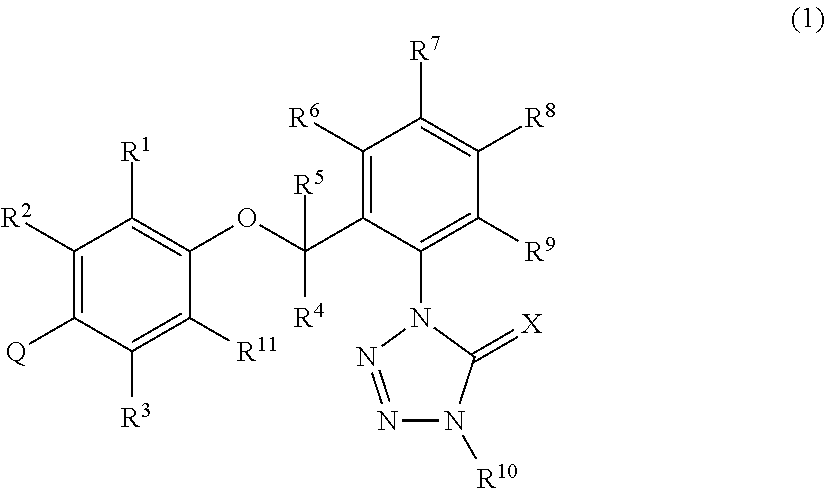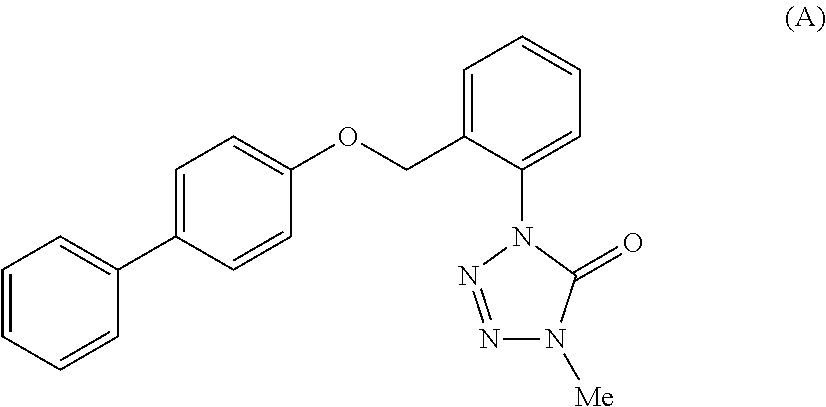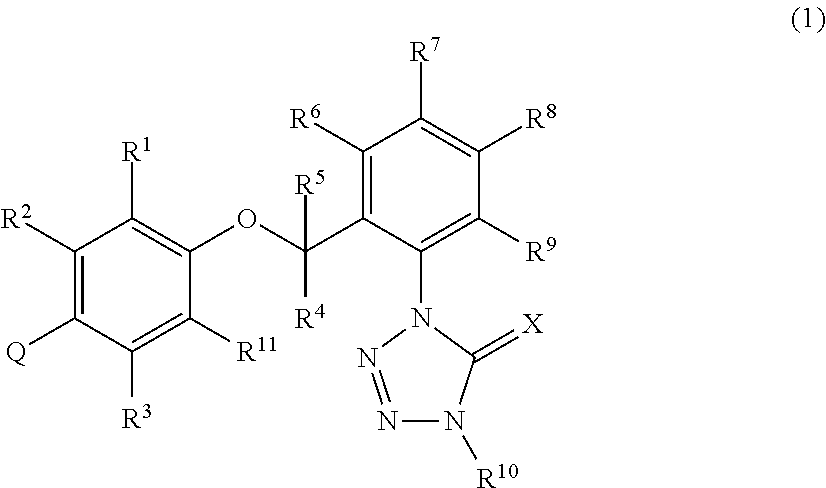Tetrazolinone compounds and applications thereof
- Summary
- Abstract
- Description
- Claims
- Application Information
AI Technical Summary
Benefits of technology
Problems solved by technology
Method used
Image
Examples
production example 1
[0920]A mixture of 0.28 g of CA55 mentioned in Reference Production Example 55, 0.27 g of the intermediate (HP27) mentioned in Reference Production Example 38, 0.20 g of potassium carbonate, and 10 mL of acetonitrile was stirred with heating under reflux for 5 hours. After cooling to room temperature, the reaction mixture was filtered and the filtrate was concentrated. The residue thus obtained was subjected to silica gel column chromatography to obtain 0.27 g of 1-{2-[2-methyl-4-(4-methylpyridin-2-yl)-phenoxymethyl]phenyl}-4-methyl-1,4-dihydrotetrazol-5-one (hereinafter referred to as the present compound 1).
[0921]1H-NMR (CDCl3) δ: 2.25 (3H, s), 2.34 (3H, s), 3.62 (3H, s), 5.20 (2H, s), 6.86 (1H, d, J=8.5 Hz), 6.95 (1H, ddd, J=5.0, 1.5, 0.7 Hz), 7.42-7.53 (4H, m), 7.67-7.73 (2H, m), 7.82 (1H, dd, J=1.5, 0.7 Hz), 8.48 (1H, d, J=5.0 Hz).
production example 2
[0922]Using the compounds mentioned in Reference Production Examples, the following present compounds were synthesized by the same reaction as in Production Example 1. Structural formulas and 1H-NMR data of the thus obtained present compounds are shown below.
Present Compound 2
[0923]1H-NMR (CDCl3) δ: 1.29 (3H, t, J=7.6 Hz), 2.14 (3H, s), 2.86 (2H, q, J=7.6 Hz), 3.61 (3H, s), 5.11 (2H, s), 6.95 (1H, d, J=8.5 Hz), 7.18 (1H, dd, J=8.0, 4.6 Hz), 7.30 (1H, dd, J=7.1, 2.1 Hz), 7.44-7.53 (3H, m), 7.58 (1H, dd, J=8.5, 2.3 Hz), 7.77 (1H, dd, J=8.0, 1.5 Hz), 8.56 (1H, dd, J=4.7, 1.5 Hz)
Present Compound 3
[0924]1H-NMR (CDCl3) δ: 2.06 (3H, s), 3.61 (3H, s), 3.93 (3H, s), 5.32 (2H, s), 6.96 (1H, d, J=8.5 Hz), 7.09 (2H, dd, J=8.2, 3.9 Hz), 7.16 (1H, dd, J=8.0, 4.6 Hz), 7.45-7.49 (2H, m), 7.54 (1H, dd, J=8.5, 2.3 Hz), 7.76 (1H, dd, J=8.0, 1.6 Hz), 8.55 (1H, dd, J=4.6, 1.6 Hz).
Present Compound 4
[0925]1H-NMR (CDCl3) δ:8.64-8.62 (1H, m), 7.75-7.63 (4H, m), 7.47 (1H, t, J=8.2 Hz), 7.16-7.13 (1H, m), 7.0...
production example 3
[1021]A mixture of 0.30 g of the present compound 61, 0.11 g of cyclopropylboronic acid, 0.05 g of [1,1′-bis(diphenylphosphino)ferrocene]palladium(II) dichloride dichloromethane adduct, 0.20 g of cesium fluoride, and 10 mL of 1,2-dimethoxyethane was stirred at 80° C. for 6.5 hours. After cooling, the reaction mixture was concentrated and the residue thus obtained was subjected to silica gel column chromatography to obtain 0.22 g of 1-{2-[2-cyclopropyl-4-(6-methylpyridin-2-yl)phenoxymethyl]-3-methylphenyl}-4-methyl-1,4-dihydrotetrazol-5-one (hereinafter referred to as the present compound 100).
[1022]1H-NMR (CDCl3) δ:0.65-0.70 (2H, m), 0.83-0.90 (2H, m), 2.00-2.09 (1H, m), 2.53 (3H, s), 2.59 (3H, s), 3.64 (3H, s), 5.13 (2H, s), 6.92 (1H, d, J=8.6 Hz), 7.03 (1H, d, J=7.5 Hz), 7.29 (1H, dd, J=6.8, 2.3 Hz), 7.43-7.38 (4H, m), 7.58 (1H, t, J=7.7 Hz), 7.69 (1H, dd, J=8.6, 2.3 Hz).
PUM
 Login to View More
Login to View More Abstract
Description
Claims
Application Information
 Login to View More
Login to View More - R&D
- Intellectual Property
- Life Sciences
- Materials
- Tech Scout
- Unparalleled Data Quality
- Higher Quality Content
- 60% Fewer Hallucinations
Browse by: Latest US Patents, China's latest patents, Technical Efficacy Thesaurus, Application Domain, Technology Topic, Popular Technical Reports.
© 2025 PatSnap. All rights reserved.Legal|Privacy policy|Modern Slavery Act Transparency Statement|Sitemap|About US| Contact US: help@patsnap.com



